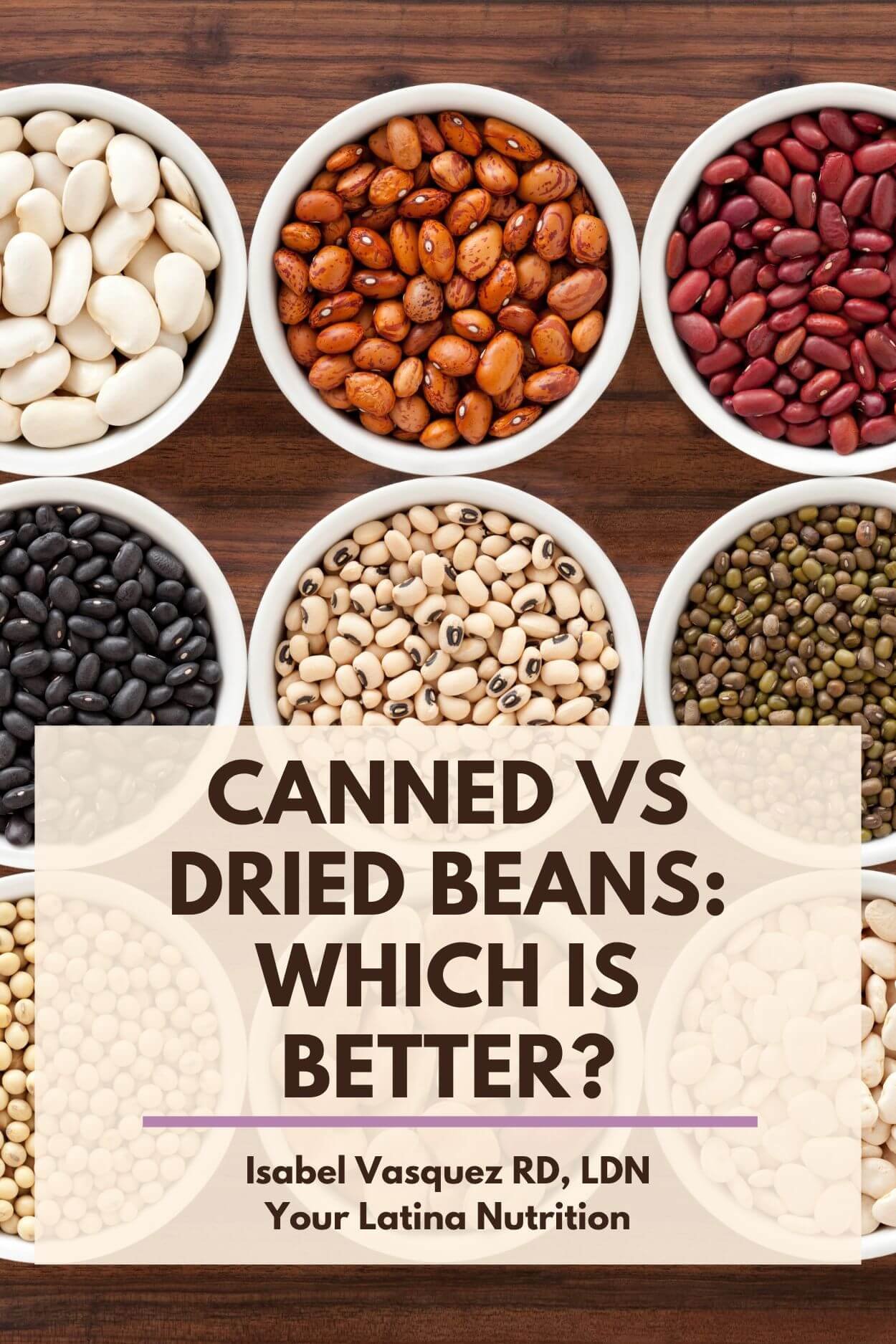Canned vs Dried Beans: Which is Better?
Written by Isabel Vasquez RD, LDN
When deciding on what type of beans to buy, you may wonder which is best, canned or dried beans?
Our Latine families often used dried beans to make delicious stewed or refried beans. Now, with our fast-paced lifestyles, we don’t always have the time to prepare dried beans.
That’s where canned beans come into play. They’re undoubtedly the more convenient option, but are they as healthy?
There’s one key nutrition difference between canned and dried beans, and that’s the sodium content.
Keep reading to learn more about the differences and similarities in nutrition, convenience, and cost between canned and dried beans.
Are Dried Beans Healthier Than Canned Beans?
When it comes to nutrition, canned and dried beans are more similar than they are different. They have almost the same amount of protein, fat, carbs, and fiber.
For reference, here is the nutrition in 1 cup of dried black beans, per the USDA:
Protein: 15.1 grams
Fat: 0.6 grams
Carbohydrates: 45 grams
Fiber: 15.4 grams
Here is the nutrition in 1 cup of canned black beans, per the USDA:
Protein: 14.5 grams
Fat: 0.7 grams
Carbohydrates: 40 grams
Fiber: 16.6 grams
Related: Are Beans Nutritious?
The main nutritional difference between canned and dried beans is their sodium content. Dried beans contain only a few milligrams of sodium per cup, while canned beans may have over 900 milligrams—40% of the daily value—per cup, per the USDA.
Consuming too much sodium may put you at higher risk for health issues like headaches, high blood pressure, and bloating, per the American Heart Association. Canned foods can be a significant source of sodium in the diet.
Canned Beans: The Most Convenient Choice
There’s no question that canned beans are a convenient alternative to dried beans. Canned beans are cooked before canning so they’re ready to eat. They’re easy to toss into salads or on top of nachos. This makes for a really quick cooking or meal prep process.
Dried beans, on the other hand, are uncooked and hard upon purchasing, so they take much longer to cook. You usually have to soak them for at least six hours to soften them.
Alternatively, you can simmer them for a couple hours or cook them in a slow cooker without pre-soaking them.
My abuela often prepared dried beans, but she spent practically all day in the kitchen making delicious, labor-intensive meals. Nowadays, most of us don’t have time to spend hours each day cooking, so dried beans may not be practical.
Ways to Lower the Sodium of Canned Beans
If you love the convenience of canned beans but you want to be mindful of your sodium intake, here are a few tips:
Purchase low-sodium canned beans. Canned beans labeled as low-sodium must have 140 milligrams of sodium—6% of the DV—or less per serving, per the USDA. Seeking out this label is a good way to know you’re getting minimal sodium without sacrificing convenience.
Purchase no-salt-added canned beans. No-salt-added canned beans often have less than 50 milligrams of sodium per cup, per the USDA. This is a great way to get the convenience of canned beans with a similar sodium content as dried beans.
Rinse the beans before using them. Another way to lower the sodium of canned beans is to rinse them before use. This helps remove a lot of the sodium.
Use salt-free seasonings. If the canned beans have sodium, you may want to opt for sodium-free seasonings when flavoring the beans. Consider using plenty of herbs and veggies like garlic, onion, and pepper, which we tend to do in our Latine dishes anyway.
Dried Beans: A Cost-Effective Option
If low cost is your top priority, then dried beans may be the way to go. You usually get more bang for your buck with dried beans. They tend to come in bigger packages and cost less than canned beans.
So, if you eat beans a lot and you’re trying to save a few bucks, dried beans may be a better option, as long as you have the time to prepare them.
To cut down on active cooking time, you can cook them in a slow cooker or instant pot.
That said, both dried and canned beans are affordable, nutrient-dense protein sources. So, canned beans are also an affordable food to incorporate in your diet.
Final Thoughts
Both canned and dried beans are nutritious, affordable sources of fiber and plant protein.
That said, if you’re looking for minimal sodium, your best bet is either dried beans or no-salt-added canned beans. If cost is your biggest motivator, dried beans tend to provide the best value. And if you want the most convenient option, there’s no competing with canned beans.
Either way, you’ll get lots of plant protein, fiber, vitamins, and minerals. We encourage you to lean on whatever type of beans will help you add more of them to your day!
For education on how to ADD nutrition to your favorite Latine cultural dishes, make peace with food, and focus on your health without dieting, join our nutrition library for just $27/month.
If you liked this post, you may also like:
Red Beans vs. Kidney Beans: A Complete Nutrition Guide

